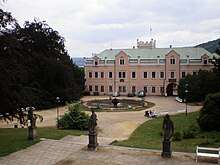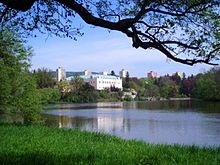Klášterec nad Ohří Castle
The castle Klášterec nad Ohří (German: Castle Klösterle an der Eger ) is located in the small town of Klášterec nad Ohří in Okres Chomutov in the Czech Republic .
history
The area of the castle is located on a hill in the immediate vicinity of the Eger . In 1515 a mansion was built there by the von Vitzthum family, initially from Saxony , which was expanded from 1590 to become a castle with a tower and four wings. Two epitaphs of the family can still be seen in the castle courtyard. Klösterle Castle in Bohemia had been the seat of the Thun and Hohenstein family since the Thirty Years' War . The family received the chateau on the Eger in 1621 after the Battle of White Mountain and kept it together with the Pětipsy chateau until the end of the Second World War . The Italian architect Carlo Lurago and the master builder and plasterer Rossi da Lucca expanded the residence into a representative residence with a loggia in 1666 . The rooms were decorated with artistic stucco in the style of the late Renaissance . Various allegorical sculptures are by Johann Brokoff . The castle is surrounded by an English-style castle park . Initially, the garden was designed as a baroque garden . Today it has many rare trees and shrubs, including a ginkgo tree. There is a sala terrena opposite the castle entrance . In front of the Sala terrena are the allegorical sculptures created by Johann Brokoff 1685–1687: Africa / America / Ulysses ( Odysseus ) / Asia / Europe.
The Thun and Hohenstein family founded the porcelain manufacture in the village in 1794 and, after a fire in 1856 and in the following years, had architectural changes made in the English neo-Gothic style . After the end of the Second World War in May 1945 and the Beneš Decrees came into force , Count Mathias von Thun-Hohenstein, as the owner of Klösterle Castle, was expropriated as the Germans were expelled from Czechoslovakia and the castle was nationalized. The old inventory was lost except for a few pictures and furniture. The castle itself survived the time in good condition. (see: Hans-Ulrich Engel: Burgen und Schlösser in Böhmen. Based on old templates, Frankfurt am Main, 2nd edition 1978, ISBN 3 8035 8013 7 , text on page 123, illustration on page 244). Since 1993 the castle has belonged to the town of Klášterec nad Ohří , which has been renovating. Today it contains a splendid porcelain collection along with a presentation of the history of porcelain production , which is presented in the castle premises. The Klášterec nad Ohří Porcelain Museum is affiliated with the Museum of Applied Arts in Prague .
See also
literature
- Viktor Karell : Castles and palaces of the Ore Mountains and Egertal. Vol. 1, Vinzenz Uhl Verlagbuchhandlung, Kaaden , 1935. (Schloss Klösterle pp. 41–43)
Web links
- Castle in Klösterle on the Eger website
- Klášterec nad Ohří Castle on kr-ustecky.cz
- Hrady.cz: Klášterec nad Ohří, zámek (Czech)
Coordinates: 50 ° 23 ′ 2.6 ″ N , 13 ° 10 ′ 25 ″ E







